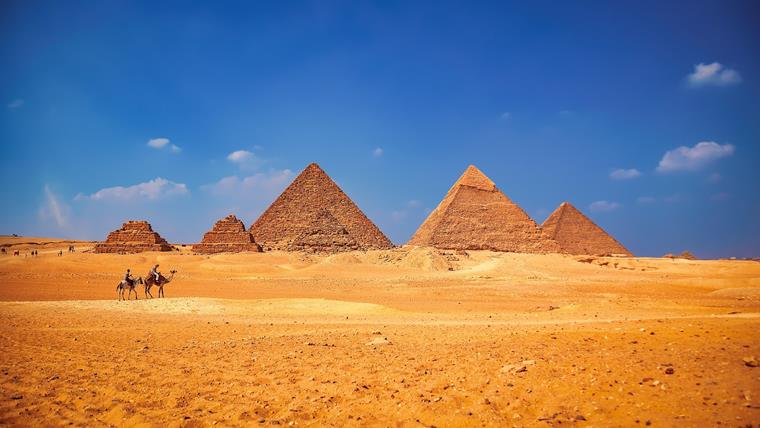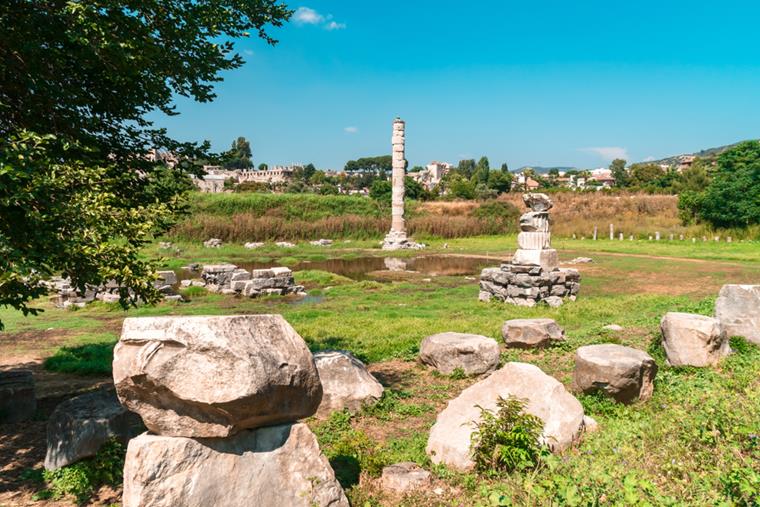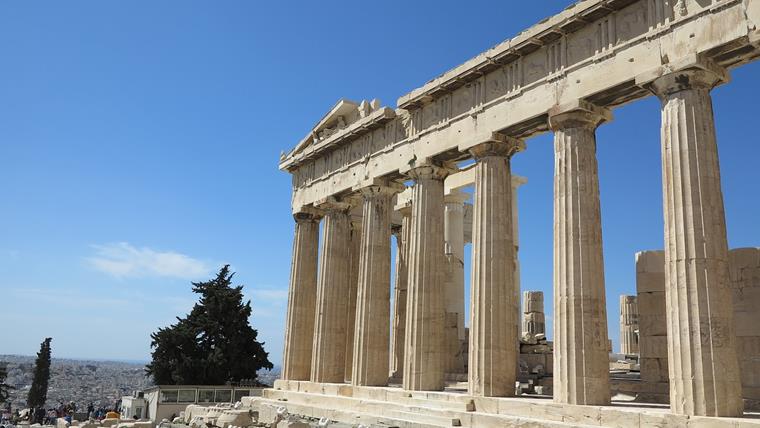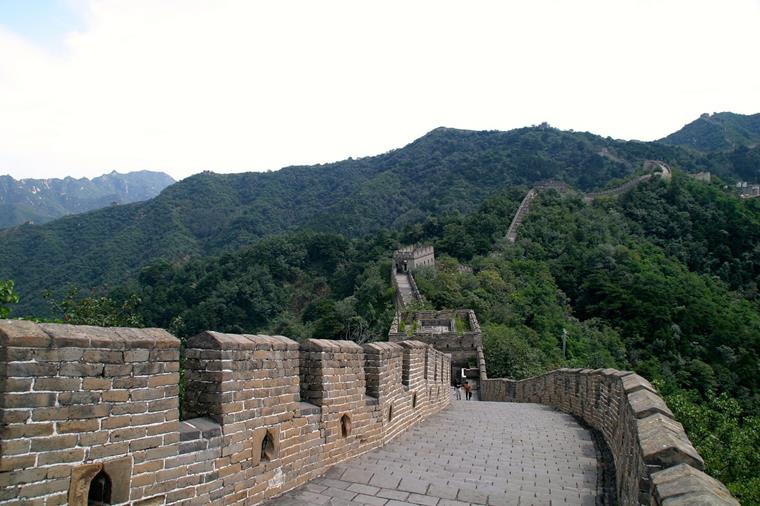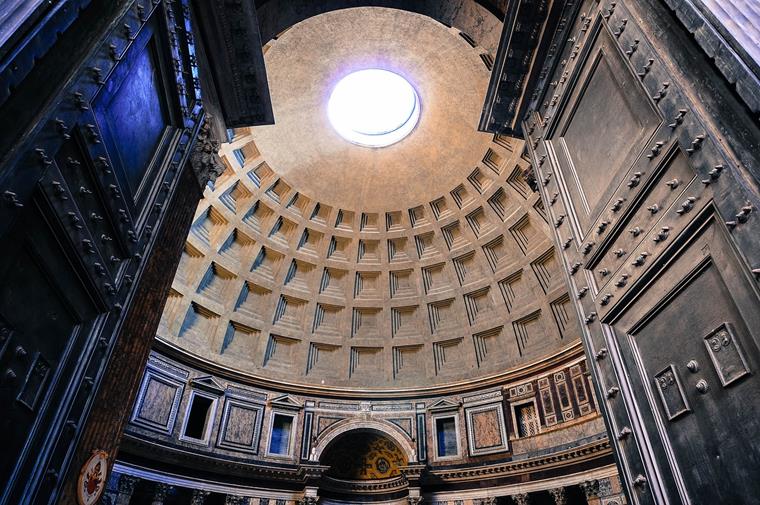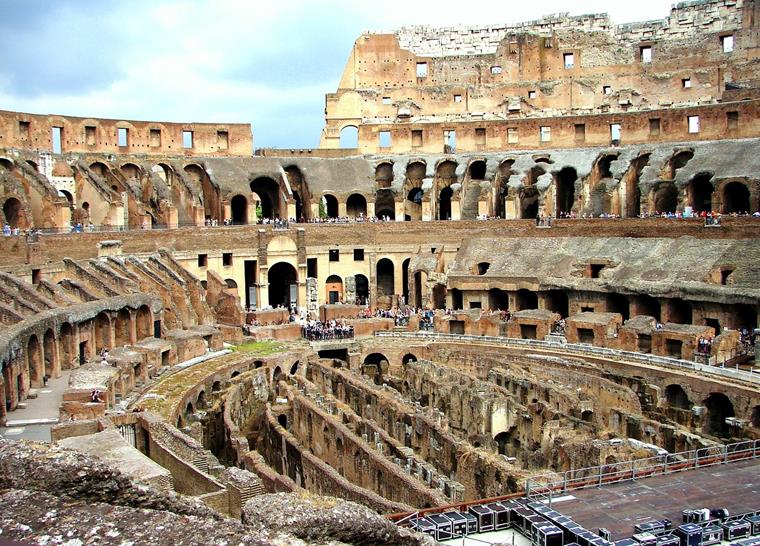Great, mighty civilizations striving for honor on the battlefields, clear class distinctions, and sumptuous palaces built on the shoulders of countless serfs: Antiquity is a colorful play of opposites. From high-quality brightly colored fabrics and shining gold, to simple textiles and dull lives of common people.
Much of what we know today about ancient times comes from written sources of learned men. We didn't keep many eye witnesses, right? A wall complex more than eighty-one-thousand meters long, which merged the flamingo states into a single unity in the face of the enemy. A temple that has had the largest self-supporting dome in the world for over two thousand years. Huge triangular towering tombs, surrounded by numerous myths and legends. All over the world, there are structures created with such dimensions of architectural art we still cannot quite grip even today.
Many impressive structures are still intact today, thousands of years after their construction. Others were not so lucky, falling victim to natural disasters or man-made destruction. Of them, we only have descriptions or canvases, but that doesn't make them any less impressive. If you want to achieve great things in the future, you also have to appreciate the past and learn from it.
Giza Pyramid Complex
Major Project of People
They are the symbol of Egypt and the source of inspiration for numerous movies, books, and conspiracy theories: the Giza pyramids. Built from 2620 to 2500 BC, that is, in the Fourth Dynasty, the three small kings' pyramids as well as the pyramids of Menkaure, Chephren, and Cheops are the only ones of the Seven wonders of the ancient world that are still preserved today.
About 9 miles from the city center of Cairo, in the Giza pyramid complex, there was an important cemetery even before the pyramids themselves. Here, archaeologists have unearthed several mastbas, that is, burial chambers, of the first, second, and third dynasties. One of the largest pyramid, the pyramid of Cheops, has still about 139 m (456 ft) today. Its original height was almost 147 m (482 ft).
The pyramids were built on a solid limestone plateau of 200 ha (494 acres). Furthermore, there were secondary pyramids, burial grounds, temple complexes, and villages built for the workers. An estimated 3 million stone blocks, each with a weight of about 2.5 tons, were used here.
The peculiarity of pyramids, and thus the source of many conspiracy theories, is the structure itself. How could people be able to create something like that? In addition to the exact, high mathematics for the calculations and the sheer effort, the transport of the building materials is still a big question mark in the minds of many people today. After all, the pyramids are in the middle of a desert.
Researchers have since been able to clarify much of this. At that time, architects were already familiar with comprehensive mathematics and were of very high rank. The angles and calculations were meticulously adhered to during the construction. For example, it is assumed that 20,000 to 30,000 people, some conscripted, many of them permanent workers, brought the heavy limestones in boats via a now dry arm of the Nile River to the pyramids.
There, the blocks were probably pulled to their destination by inclined clay ramps. According to the current state of science, the pyramids were not built by serfs, but were a project of the entire nation in order of their Pharaohs. Everyone involved certainly did their best. Truly an impressive and hard to imagine form of early architecture.
Hanging Gardens of Babylon
Mysterium of Babylon
Not much is known about the Hanging Gardens of Babylon. The construction is usually dated to 775 BC. It is even questionable whether this structure ever existed. No records can be found of direct witnesses, and the only reference to their existence comes from the fact that the Roman historians have quoted probably lost documents.
The city of Babylon was built about 5,000 years ago, and the rulership has changed steadily. After the death of Alexander the Great, the city began to decay, marked by wars and famines, and around 100 BC, it was completely destroyed. Today, only the excavated remains of walls remind you of the once wealthiest and largest city in the world.
The name of the "Hanging Gardens" is probably a translation error from old Greek documents. If correctly translated, this building would be called "Roof Garden on Terraces". This is a bit easier to imagine. According to records, the step terraces are about 100 m (328 ft) wide and long.
It is said that seven of them were lying on top of each other and they were planted with tropical plants from all over the world. An ingenious watering system probably brought the water of the Euphrates River as far as the uppermost terrace, where it was then channeled downwards over the others.
It has not yet been possible to confirm the existence of this structure. There are no archeological findings or written sources from that time that would mention it. It is also assumed that this form of the irrigation system has been invented much later. Nevertheless, the mere idea of such a beautiful structural project is more than impressive, and still has a great influence on our architecture today, for example, on the Italian terraced gardens.
Temple of Artemis
World's Largest Temple
The Temple of Artemis at Ephesus was built around 440 BC. There should have been at least three other temples there before, but each time fell victim to destruction by floods or humans themselves. Unfortunately, this series was to be continued.
According to ancient records, the construction of the temple started in 440 BC, and it took 120 years. This temple had some special features, such as the first Marble Architrave in Greek architecture, which spanned from column to column. This created the largest span ever achieved by the Greeks. The dimensions themselves were also something special, as it was the largest temple in the world at the time.
Barely 100 years later, in 356 BC, the monument was destroyed by arson. A man named Herostratos confessed under torture that he wanted to make his name immortal by destroying this wonder of the world. He certainly succeeded in that. The temple was rebuilt on a base with the dimensions of 125.67 m × 65.05 m × 2.7 m (412 ft times; 213.5 ft times; 8.85 ft). It took about 100 years to create a larger version of the temple that has been burned down.
However, the nearby river allowed the land to grow further and further into the sea, so the area gradually becomes more swampy. Around 250 BC, the construction was discontinued and the temple was finally destroyed under Constantine the Great. The remains were obstructed or sunken in the swamp. Today, only a single erected column reminds of the dimensions of the Artemis temple.
Acropolis
From Castle to Temple Complex
From today's Turkey, it goes directly to neighboring Greece. The symbol of the capital, Athens, is undoubtedly the Acropolis in Athens. The term can be translated from ancient Greek as "Upper City of Athens". In this way, the city's fastenings were referred to as the acropolis. The mighty castle hill with its temple complexes rises far above the roofs of Athens.
At first, the Acropolis in Athens was typically a stronghold. Already in the 14th century BC, this is where the king had his seat. Later, in Democratic Athens, the Acropolis was considered as the seat of the gods. After the Persians captured the city in 480 BC, devastating the archaic Acropolis, the temple complexes were completely redesigned and rebuilt after Athens' eventual victory under Pericles.
The Doric, Ionic, and Corinthian column arrangements were used. This diversity created breathtaking temple complexes that are still a big tourist attraction today. The Parthenon, the centerpiece of the Acropolis, is not only aesthetically pleasing with its sheer size. Its numerous pillars provide it with great stability and durability. This allowed the structure to withstand all this time.
The temple complexes in Athens are an outstanding example of the refinement and precision, characteristic for Greek architecture. The majestic columns in particular make it one of the most famous structures in the world and a role model for later temple buildings.
Great Wall of China
United in Face with Enemy
Defending borders with walls has always been a tradition in China. In ancient times, China consisted of numerous splinter states, which were often hostile to each other. For this reason, the first reinforcements against other warping Chinese states was created already around 700 BC. These walls consisted largely of rammed earth, interspersed with layers of straw and brushwood. Since earth is rather unsuitable for the areas with precipitation and without regular maintenance, hardly any parts of it have been preserved.
Only later did the numerous states band together to defend themselves against the Xiōngnú, a tribal association of equestrian nomads. Between 300 BC and 100 AC, they controlled large parts of Asia and posed a strong threat to the Chinese tribes.
According to some traditions, around 220 BC, Qin Shihuangdi, the first Chinese emperor, had let built a long wall with "over 10,000 li' to fortify the northern border against the Xiōngnú. In Chinese, the dimension 10,000 li stands for infinity, not for the actual length of the wall. Since there was usually no clay on site, natural stone slabs were layered on top of each other.
The today's image of the Great Wall of China – the wide paths and neatly arranged stones with their towers – comes from the construction projects of the Ming Dynasty from 1473 to the 17th century. So these parts, which are most likely to be maintained due to tourism, no longer date from ancient times. Therefore, the Great Wall of China, as we mostly see or read about it in reports, is more of an architectural wonder of the modern era, which doesn't make it any less impressive.
Pantheon
Temple of All
When it comes to architectural masterpieces in ancient times, the Pantheon should not be missing, of course. The former temple is one of the best-preserved ancient buildings in Rome. The main reason for this is that it was consecrated relatively early after Christianity became established as the state religion. Thus, it was spared from evangelical wars.
It was designed and built to honor all the Roman deities. The name is composed of "pan", which means all, and "theos", which means "God". In the second century AD, it was commissioned by the Roman ruler Hadrian. Until 110 BC, the Pantheon was destroyed by fire caused by lightening strikes.
The most interesting structural feature is the dome, which has still been preserved. A true architectural masterpiece that has fascinated people for over two thousand years. To date, it is the largest non-reinforced concrete dome in the world.
The records of this building are far more extensive and better preserved than for the previous ones. Therefore, we know very well today about the exact construction method. The step rings, with different strengths, at the base counteract the tension forces and ensure that horizontal forces are transferred downwards into the walls.
The dome reduces in thickness from 5 m (16.4 ft) to 1.5 m (4.9 ft) at the opening to the sky. A ring of bricks with a thickness of 1.4 m (4.6 ft) transfers pressure around the opening. With a diameter of 43 m (141 ft) and a height of 24 m (78 ft) , the dome alone is an architectural masterpiece. The Pantheon has always been a role model and inspiration for future generations of architects.
Colosseum
Backdrop for Bloody Spectacle
Take a deep breath, enter the huge amphitheater, break away from the shadows of the wide arches, and step into the light of the Roman sun. You are already in a completely different world. Loud cheers, surprised cries, and the roars of the spectators make the ground tremble. In the middle of the arena, you can make out men huffing, looking into each other's eyes, before attacking each other, goaded by the cheers of the crowd.
The whirring of arms whirling through the air and crashing into each other. In addition, the roar of lions or bears let loose on each other or on people, accompanied by fanfares and other music performances. Entertaining, gory spectacles, music, violence, and death: In this way, thousands of visitors were regularly attracted in the ancient Roman Empire.
As the most recent and final building of our blog post, we would like to show you another wonder of architecture in Rome: the largest ancient amphitheater. With 80 entrances, the Colosseum invited up to 80,000 spectators to the brutal spectacles free of charge and was the center of entertainment in ancient Rome. It still attracts many visitors today, although many of the impressive walls are no longer intact. About 40,000 slaves worked on this project, which, with a center length of 188 m to 156 m (610 ft to 511 ft) and a height of 54 m (174 ft), became the largest closed building in ancient Rome.
It is not only the massive dimensions of the elliptical amphitheater that are special; especially the three superimposed rows of arcades, each with 80 arches, were a masterpiece of construction. The impressive outer walls of the Colosseum were built with Roman travertine, a southern limestone. Inside, cheaper bricks and tufa were used, probably for cost and functionality reasons. Under the arena of that time, there was a flooded area to stage sea battles. Later, numerous tunnel and supply systems were created there, another sign of how progressive the Roman architecture must have been at that time.
Conclusion: Ancient Architecture
All these impressive structures show us today, what structural achievements the people of that time were capable of. The architects and site managers implemented incredible projects – and from today's point of view, they used the simplest means and tools. Whether on limestone or in swampy areas, they created structural masterpieces, many of which are still preserved today.
Rulers often have big plans and are looking for courageous architects who dare to go further than any person had dared to before. Innovative construction methods, special materials, and meticulous mathematical accuracy ensured that such structures could be created in the first place.
For the construction industry, these relics of the past can be a source of inspiration and admiration. We should dare to try new things and test the limits in the construction industry today. With our modern technology, so much more is possible than setting a third congruent reinforced concrete building in the middle of a city center. We can still learn a lot from the old master builders and also help our modern world with more structures that will inspire generations after us.
If you'd like to listen to this blog post, you can find the episode in German on our podcast:
More About Our Podcast